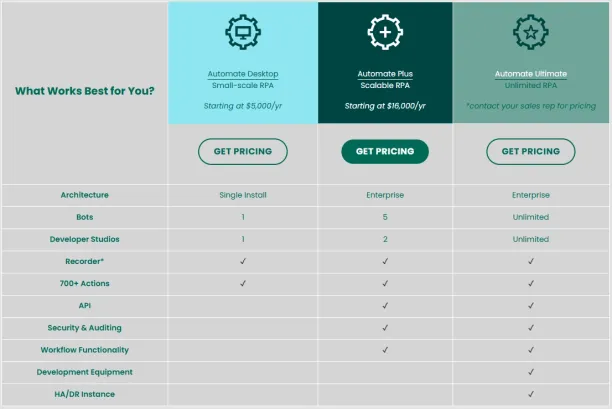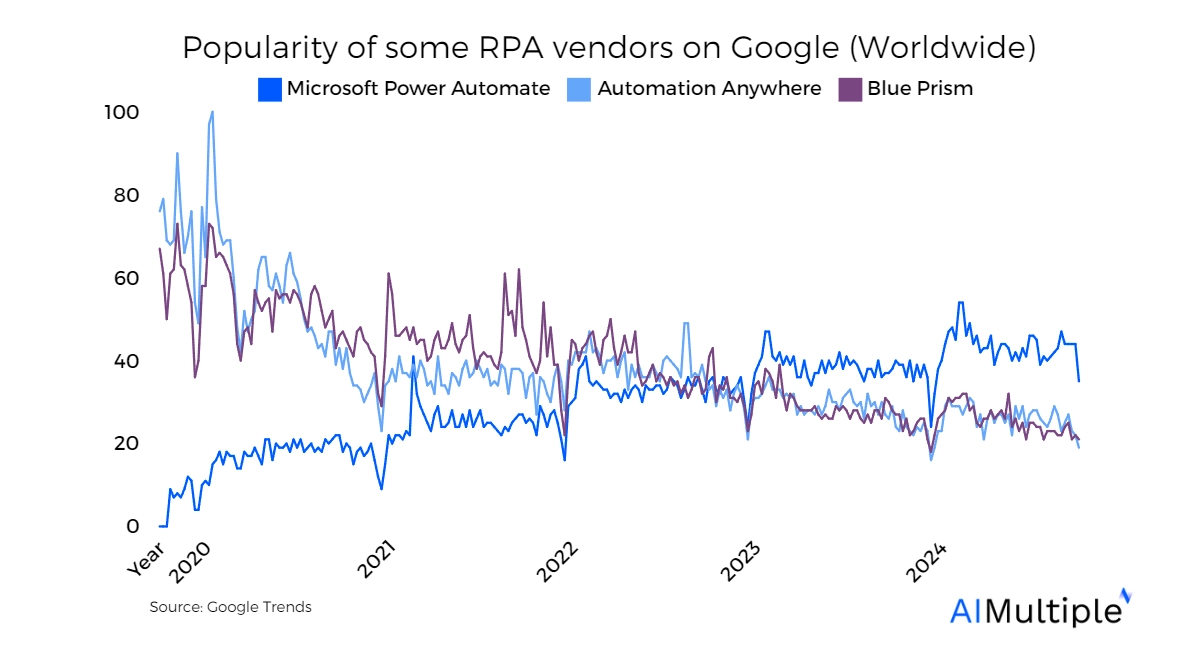Operational costs can deter (especially smaller) organizations from investing in RPA and missing out on automation benefits. These costs are the licenses for RPA software, RPA programming, and RPA tools.
Follow the links to see cost-effective RPA vendors:
| Vendor | Best for | |
|---|---|---|
1. | No-code automation | |
2. | Bot Pricing | |
3. | Microsoft ecosystem | |
4. | Ease of use | |
What is affordable robotic process automation (RPA) software?
Microsoft Power Automate
Microsoft Power Automate’s RPA technology offers a user-friendly interface for creating RPA bots. Its cognitive features include NLP, ML, and predictive analytics.
Pricing:
- Attended processes: $15/user/month
- Unattended bots: $150/bot/month
UiPath
UiPath is the most commonly used RPA solution thanks to its early market entry and easy-to-use interface.
Pricing: $420/month with 1 unattended and 2 attended bots.
Argos Labs
Argos Labs’ no-code RPA is built on Python, which makes it flexible and capable of handling complex automation tasks. It can integrate with leading AI/ML/OCR engines for end-to-end intelligent automation. Its Supervisor feature offers an analytics dashboard, providing users with real-time monitoring of bot status and analytics for bot utilization.
Pricing: For $500/month, Argos Labs provides a developer account and 3 deployment environments that can support an unlimited number of bots. For more, see RPA pricing.
Fortra Automate
Pricing: Fortra’s basic plan costs $416 monthly, including one bot and a developer studio.
Unlike many other RPA vendors, prices of attended and unattended bots are equal.

Our evaluation criteria
The global RPA market is growing every year, with 50+ current RPA market players.
We relied on 3 publicly-verifiable metrics to produce our shortlist:
- Price of $500/month or less for a starter package
- 20+ employees
- At least one F500 reference
Open-source RPA solutions
Open source RPA is a code-based RPA software that leverages programming languages like Python for automation scripting. Therefore, its users need programming knowledge. Most of them have Visual Studio Code extensions to make it easier to program bots. They can be implemented for free.
See: A comprehensive list of open-source RPA software.
Features to look for when selecting an affordable RPA tool
Besides their price, here are the main capabilities you can assess the vendors by:
1. UI
When an RPA vendor claims to offer a no-code RPA solution, it means citizen developers can build attended and unattended RPA bots and undertake RPA reconfigurations with minimal coding knowledge.
A benefit of no-code solutions is that business teams can automate their processes in-house. This allows them to proceed faster and at a lower cost since it reduces reliance on the technical team.
However, if your RPA team is fluent in Python or other programming languages, you may prefer Python RPA.
2. Partner ecosystem
Having a selection of partners with experience in the specific RPA solution gives enterprises more options when buying RPA services.
Enterprises may work with an RPA consulting firm for several reasons:
1.1. Strategy & best practices
RPA consultants can help define an RPA strategy that aligns the automation journey with business goals and helps identify the most suitable processes for automation. They can also guide the organization on best practices for implementing and managing RPA.
1.2. Training & skill building
If your teams still don’t have the skill to automate their workflows, a consultant can provide the necessary training and skill-building to better utilize the platform.
Learn more about RPA training.
1.3. Change management
Implementing RPA can bring significant changes to an organization’s workflows and its culture. A consultant can help with change management and ensure a smooth transition.
1.4. Troubleshooting & support
No-code tools aren’t immune to complexities. An RPA consultant can assist with these challenges and provide advanced support.
1.5. Scaling
If an organization plans to scale its automation efforts, a consultant can provide valuable guidance on how to effectively and efficiently grow and implement RPA in usage, including how to manage governance and compliance and lower RPA scaling costs.
3. Cognitive automation
Cognitive automation, also intelligent automation, is the ability of RPA bots to interact with other tools, like OCR and NLP, to go beyond solely automating rule-based tasks. So these features enable it to handle both structured and unstructured data and make decisions based on context.
For instance, consider data entry from paper invoices into the accounting system:
- Bot without intelligent automation: The RPA bot without access to AI plugins can only handle structured forms, where every field is in the same place and with a standard format. If an invoice deviates from the format, the bot won’t be able to process the data correctly.
- Bot with intelligent automation would be more flexible. Optical Character Recognition (OCR) converts paper invoices into digital files. Natural Language Processing (NLP) helps extract information from unstructured data. If the invoice format is changed, the bot can still correctly interpret and enter the data. ML algorithms also help the bot learn from past actions to improve its accuracy over time.
4. Integrations
An RPA solution needs to connect, interact, and work with other software applications, systems, and services. Having a wide range of off-the-shelf integrations will result in cost reduction because companies won’t need to pay for custom integration.
Integration usually involves using APIs to enable the bot to interact with apps. RPA platforms that come with pre-built connectors for popular business apps make integrations easier and allow more workflow automation across different business processes.
What are the disadvantages of an expensive RPA tool?
Organizations started exploring affordable RPA alternatives as the market matured and got commoditized. As a result, there is increased interest in platforms like Microsoft Power Automate that offer lower licensing fees, as you can see below. However, Microsoft’s scale is also important in the increasing popularity of MS Power Automate.

FAQ
What is affordable robotic process automation?
Affordable RPA tools provide the same functionalities as pricier options but at a lower cost. Business leaders should find affordable robotic process automation tools that will cover their automation needs, without straining their budgets.
RPA solution pricing and RPA deployment costs can be expensive. For instance, UiPath’s basic package costs ~$5,000/year.
There are free and freemium RPA packages, but they are functionally limited and/or lack customer support. The last option is open-source RPA, but these have limited support, need coding knowledge, and are yet to have the momentum to shape RPA’s ecosystem.
A new cohort of RPA vendors is emerging that offer open-source robotic process automation tools, but with back-end support. These solutions are often not provided big RPA vendors, but smaller companies that rely on open-source and community-driven developments to offer an affordable and accessible RPA solution.
If RPA vendors:
– Offer more economical licensing packages
– Allow users to pay for only what they need
– Expand their partnerships
They would be more appealing to more organizations.
What is robotic process automation?
Robotic Process Automation (RPA) streamlines repetitive and time-intensive tasks.
Automated processes:
– Free up employees’ time
– Allow them to focus on higher-value tasks
– Result in cost savings, thanks to reduction of manual work
– Eliminate human errors
However, despite the numerous RPA benefits, a Deloitte survey puts RPA adoption at only 53%.
For more on RPA development
To learn more about RPA development, read:







Comments
Your email address will not be published. All fields are required.